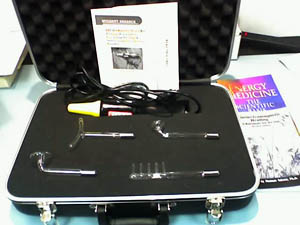|

|
|
|
|
October 2017 
|
|
We are happy to announce that
the University of Maryland, down the street from our IRI
offices, took Second Place in the annual USDOE Solar Decathalon https://www.solardecathlon.gov/ this
month beat only by the Swiss. It is a fantastic competition among
colleges and universities to design and build a full-size,
solar-powered house on the site of the event. Visit the website
for a short video and more information. Another interesting
inspiration is the group of luminaries who have banded together
under Director Tom DeLonge's guidance for a TotheStarAcademy which
have high hopes for solving all of the space travel issues
themselves. Nice video on their homepage. Onward and upward!
Our first story #1 this month
upgrades the previous report that FE eNews did in June 2015, Enews which
included a short video to the MIT experiment proving that
electricity can be generated from a coated polymer, expanding and
contracting, using a piezoelectric attachment. Now Yale and
Columbia University predict that such generators can be placed on
the surface of reservoirs to yield up to 70 per cent of the
electrical needs for the US. Certainly renewable energy by any
definition.
The Story #2 celebrates the
world's first floating wind farm, which in this age of rising sea
levels from climate change, is a hopeful development that can
ride the tide. Hats off to the Scottish Hywind farm for
generating a 30 MW capacity in this manner.
Story #3 is a major development
in bioenergetics. Now electrotherapy has gone where no electrons
have gone before, in restoring consciousness by stimulating the
vagus nerve of vegetative state patients with ever increasing
amounts of microcurrent. A related story reflects a backyard
walking experience which everyone can have to absorb earth ground
electrons, which are natural antioxidants.
Our Story #4 introduces the first
electric dump truck which even uses the engine in braking
downhill to recharge batteries. This leads us into the larger
picture of Story #5 that predicts the end of the fossil fuel
internal combustion engine, with car makers like General Motors
and Volvo making only electric cars by 2023. Of course, the
electric car charging station corridor coast to coast is now a
hot topic in Time as
well as in the Wall Street Journal WallStreetJournal and
Fortune magazine Fortune
|
|
|
Our Best Selling nano second PEMFdevice
|
|
|
Our most popular HIgh voltage device
|
|
|
|
Best NanoSecond PEMF for arthritis, bone issues
|
|
|
|
1) Energy Harvested from Evaporation
Could Power most of the US
|
|
|
By Columbia University, Office of
Public Affairs, October 2017
A recently published study estimates that up to 70
percent of the United States' electricity needs could be met
through a newly devised system that harvests power from
evaporation. This novel renewable power source uses bacterial
spores to generate electricity and can sit on top of lakes and
reservoirs.
Back in 2015, Ozgur Sahin and a team of scientists from Columbia
University revealed an exciting new potential source of renewable
energy. The team had created a way to generate energy from the
natural process of evaporation using a certain type of bacterial
spore. These spores expand and contract as they absorb
evaporating moisture, and this oscillating motion could be
harnessed to generate a small amount of power.
The team developed a device that held these spores and to prove
the system's effectiveness created a miniature car that ran on
this evaporation energy system. At the time the technology was an
interesting concept but one not hugely appropriate for
large-scale implementation.
|
|
2) World's First Floating Wind
Farm Powers Up off the Coast of Scotland
|
|
By Michael Irving,
New Atlas.com October 18, 2017
Offshore wind farms like the
Gemini facility in the Netherlands can tap into the higher
average wind speeds over the ocean, but unfortunately these
facilities can only be built in relatively shallow water.
Floating turbines can help harvest wind energy from above deeper
waters, so to that end, the world's first floating wind farm has
just fired up off the coast of Scotland.
Floating some 25 km (15.5 mi) off the coast of Aberdeenshire,
Scotland, the Hywind farm has a capacity of 30 MW and will supply
power to about 22,000 homes. Spaced over an area of about 4 sq km
(1.5 sq mi), the farm is made up of five 6-MW turbines that stand
253 m (830 ft) tall, taking advantage of average wind speeds of
10 m (33 ft) per second.
While this pilot facility is a far cry from the 630-MW London
Array, the world's largest offshore wind farm, it does have a key
advantage: its floating turbines can operate in water up to 800 m
(2,625 ft) deep, 10 times deeper than the upper limit of fixed
facilities. That drastically widens the net of viable locations
for offshore wind farms, a technology with incredible
energy-generation potential.
|
|
3) Restoring Consciousness with
Electrotherapy
|
|
Published on Cell Press Current
Biology
Article
Link
Researchers have developed a
device that can rescue failing body functions with
electrotherapy.
Patients lying in a vegetative
state present severe impairments of consciousness [1] caused by
lesions in the cortex, the brainstem, the thalamus and the white
matter [2] . There is agreement that this condition may involve
disconnections in long-range cortico-cortical and
thalamo-cortical pathways [3] . Hence, in the vegetative state
cortical activity is 'deafferented' from subcortical modulation
and/or principally disrupted between fronto-parietal regions.
Some patients in a vegetative state recover while others
persistently remain in such a state. The neural signature of
spontaneous recovery is linked to increased thalamo-cortical
activity and improved fronto-parietal functional connectivity [3]
. The likelihood of consciousness recovery depends on the extent
of brain damage and patients' etiology, but after one year of
unresponsive behavior, chances become low [1] . There is thus a
need to explore novel ways of repairing lost consciousness. Here
we report beneficial effects of vagus nerve stimulation on
consciousness level of a single patient in a vegetative state,
including improved behavioral responsiveness and enhanced brain
connectivity patterns.
RELATED ARTICLE
Walking
barefoot makes body collect electrons
|
|
4) World's First Electric
DumpTruck Uses Gravity Power to Recharge
|
|
|
By Mark Dansie,
Revolution Green.com
The E-Dumper weighs a whopping 45
tons and has 700 kWh of storage capacity. That's as much as
eight Tesla Model Svehicles. To ensure it is as
environmentally-friendly as possible, the E-Dumper's base is a
used Komatsu HD 605-7 dumper truck. The original diesel
engine has been removed and replaced with a chassis for battery
packs that will power the new E-Dumper.
Its tires measure over 6.5 feet
in diameter, and the driver is required to climb nine stairs to
reach the cabin. Its size and strength ensure it can
transportmaterials from a mountain ridge to a valley 20 times per
day. This is important, as moving materials from the slopes of
the Chasseral to the Ciments Vigier SA cements works near Biel is
what the e-dump truck will be doing for the next 10 years.
Because the vehicle is electric, there is no need to "heat
up" the brakes when descending. This is because the enormous
electric engine acts as a generator and recharges the battery
pack. That same energy is then used to help the vehicle travel
back up the hill. Phys reports, "If all goes as planned, the
electric dumper truck will even harvest more electricity while
traveling downhill than it needs for the ascent. Instead of
consuming fossil fuels, it would then feed surplus electricity
into the grid."
The costly venture is being spearheaded by Ciments Vigier SA.
Lithium Storage GmbH from Illnau and the Kuhn Group have been
hired to "get the ball rolling," so to speak. The
project is also backed by Empa; battery expert Marcel Held is in
charge of safety assessments.
Read More
|
|
5) Why 2017 is the
Beginning of the End of the Internal Combustion Engine
|
|
By Peter Holley The Washington
Post October 11, 2017
Article Link
Electric vehicles no longer seem
like a futuristic fever dream, but they remain a rarity on most
American city streets, accounting for less than 1 percent of the
nation's auto sales, according to the automotive website
Edmunds.com.
Yet, when future auto historians
look back, they may pinpoint 2017 as the year electric vehicles
went from a promising progressive fad to an industry-wide
inevitability.
The tipping point, experts say,
follows three developments, each rippling outward with economic
and cultural consequences.
GM
Announces it will make only Electric cars
|
|
If you enjoy this service, take individual action
by clicking on the button below. We are a 501 (C)3 Non
Profit Institute and your donations are fully deductible to the
maximum allowed by law.
|
|
|
|
|
|

|
|




















